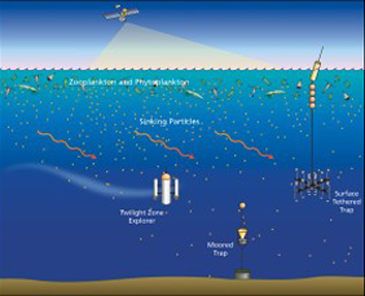There is a dimension in the oceans between sunlight and darkness. It is a dimension where organisms wait for the unwary, the dead, and the unclean. It is a dimension known as the twilight zone.
 Studying the twilight zone may help scientists understand more about Earth's climate. Credit: Woods Hole Oceanographic Institution
Studying the twilight zone may help scientists understand more about Earth's climate. Credit: Woods Hole Oceanographic InstitutionThe surface of the oceans is bathed in sunlight. By depths of a few hundred feet, though, most of the light has been absorbed. A bit filters through -- enough to make out shadowy shapes. But it’s not enough to support photosynthesis -- the process that provides energy for bacteria and plants. This region extends to depths of a couple of thousand feet, below which there is no sunlight at all.
Most of the animals in the twilight zone move slowly to conserve energy. They wait for prey to come to them -- perhaps lured by light produced by the predators themselves. They eat not only living organisms, but the bodies of the dead as they drift toward the bottom, as well as the wastes of animals in the sunlit upper layers.
The twilight zone could play a role in regulating Earth’s climate. Microscopic organisms at the surface combine carbon dioxide from the atmosphere with water and sunlight to grow. When they die, they sink to the bottom. Over time, some of their remains form rock, trapping carbon.
Organisms in the twilight zone eat many of these dead organisms before they can reach the bottom and recycle the carbon back into the ocean -- and eventually, the air. So probing the twilight zone will help us understand how much carbon the oceans can hold -- one of the keys to the “twilight zone” of global climate change.

